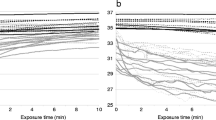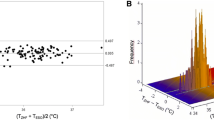Abstract
Electrocardiogram, body temperature and heart sounds are important variables to monitor during anaesthesia. An oesophageal probe for combined monitoring of these variables has been designed. Special consideration has been given to the potential hazards of placing devices close to the heart and in direct contact with the delicate oesophageal mucosa. The probe contains segmental silver electrodes for e.c.g. recording and a miniature accelerometer for heart sound detection, located close to the tip of a 5 mm O.D. PVC tubing.
Similar content being viewed by others
References
Demer, J. L., Mylrea, K. C., Adler L. andJewett, W. R. (1978) An esophageal multiprobe for temperature, electrocardiogram, and heart and lung sounds measurements.IEEE Trans.,BME-25, 377–380.
Iwata, A., Ishii, N., Suzumura, N. andIkegaya, K. (1980) Algorithm for detecting the first and the second heart sounds by spectral tracking.Med. & Biol. Eng. & Comput.,18, 19–26.
Newbower, R. S. andCooper, J. B. (1979) Comments on “An esophageal multiprobe for temperature, electrocardiogram, and heart and lung sounds measurements”.IEEE Trans.,BME-26, 309.
Severinghaus, J. W. (1957) The Telecor an esophageal probe monitoring device.Anesthesiology,18, 145–149.
Author information
Authors and Affiliations
Rights and permissions
About this article
Cite this article
Linnarsson, D., Ribbe, T. & Hallén, B. Oesophageal probe for heart and temperature monitoring during anaesthesia. Med. Biol. Eng. Comput. 20, 390–392 (1982). https://doi.org/10.1007/BF02442810
Received:
Issue Date:
DOI: https://doi.org/10.1007/BF02442810




